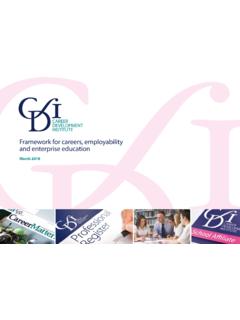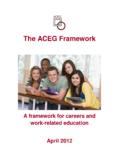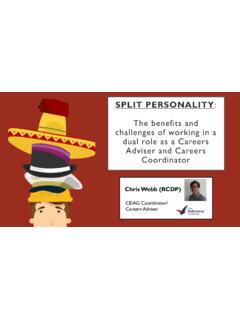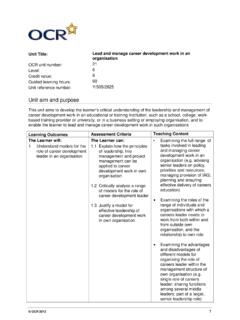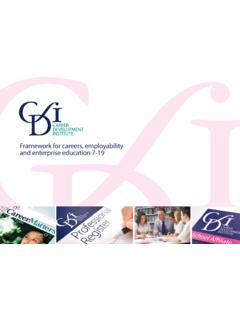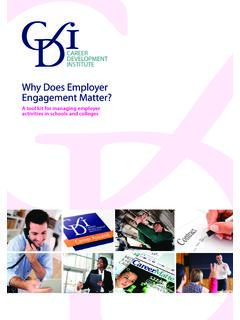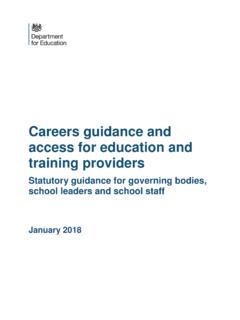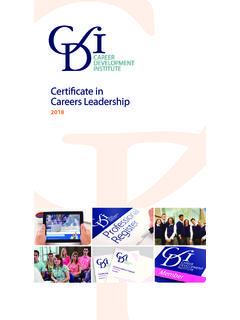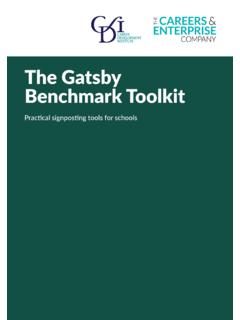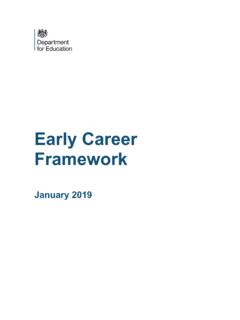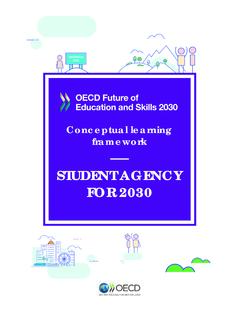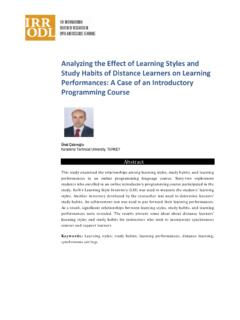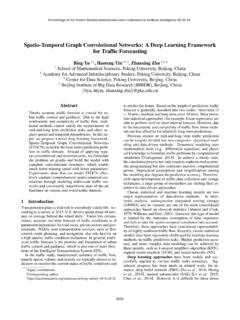Transcription of The ACEG Framework - the CDI
1 The ACEG Framework A Framework for careers and work-related education April 2012 2 Acknowledgements ACEG would like to thank the working group who led the development of the Framework (David Andrews, Rusty Ansell, Anthony Barnes, Sue Barr and Pete Walthorne). In addition, ACEG would like to thank the members of the Consultative Council (2011-12), participants at the Conference for CEIAG advisers (November 2011), the Advisers and Inspectors for Careers Education group, Barbara McGowan and Faith Muir for their comments and contributions. 3 The ACEG Framework Careers and work-related education in England for 7 to 19 year olds Contents 3 Introduction 4 What is careers and work-related education? Rationale for a new Framework The relationship to careers guidance Who the Framework is for How the Framework was developed The ACEG Framework 6 Getting started Essentials of the Framework Key Stage 2 learning outcomes Key Stage 3 learning outcomes Key Stage 4 learning outcomes Post 16 learning outcomes Progression chart (KS2 to Post 16) Guidance on using the ACEG Framework 19 About learning outcomes Managing the curriculum 4 Introduction The ACEG Framework is a new Framework and guidance for careers and work-related education (CWRE) in England.
2 At its heart is a set of recommended learning outcomes for key stage 2, key stage 3, key stage 4 and post-16 education and training. The guidance includes advice on the organisation, leadership and management of CWRE. What is careers and work-related education? The widely accepted definitions of career and work-related learning emphasise that: Career learning helps young people develop the knowledge, understanding and skills they need to make successful choices and manage transitions in learning and work. Work-related learning provides opportunities for young people to develop knowledge and understanding of work and enterprise, to develop skills for enterprise and employability and to learn through direct experiences of work and enterprise. The ACEG Framework brings these two descriptions together in a single definition: Careers and work-related education (CWRE) describes the planned provision by schools, colleges and their partners to enable young people to learn about careers, learning and work so that they can manage their own development and make life choices and decisions that will benefit their own wellbeing and contribute to the wellbeing of others.
3 Rationale for a new Framework Young people in our schools and colleges today face a future that will be very different from that experienced by their parents and teachers. As the statutory age for participating in learning is raised to 17 in 2013 and to 18 in 2015, the initial phase of education and training will last for more years. Opportunities in higher education and apprenticeships are changing rapidly. Individuals must expect to experience further periods of learning and updating of their skills on a lifelong basis. Working life will involve more moves from one job to another than happened in previous generations, and will extend to a later pensionable age. Careers in the 21st century will be quite different from those in the 20th century. Finding the right job will be replaced by the need for young people to be equipped with the knowledge, 5 understanding, skills and personal qualities to plan and manage their progression through learning and work.
4 Access to expert and timely careers guidance will be important but providing support for choices and transitions through individual discussions alone is neither effective nor efficient. Young people also need the knowledge and skills developed through careers and work-related education to make good use of the guidance provided and to plan and manage their own careers. Effective careers and work-related education contributes also to raising aspirations, supporting achievement, increasing participation and improving social mobility for disadvantaged young people. Until now these aspects of the curriculum have been described, organised and delivered in different ways depending on the perspectives and priorities of policy-makers at national, local and school level. QCDA brought the two together, alongside enterprise and personal finance education, within the economic wellbeing strand of the non-statutory programme of study for personal, social, health and economic (PSHE) education.
5 The ACEG Framework continues this approach. In fact, in many schools these areas of the curriculum have already been integrated and are managed by the same curriculum leader. Where several members of staff are involved it is hoped that the Framework will support a more holistic approach. The Framework brings the two areas of the curriculum together, into careers and work-related education , and combines the three aims of careers education (self-development, career exploration and career management) with the three strands of work-related learning ( learning about work, learning for work and learning through work). The Framework includes recommended learning outcomes for key stage 2, key stage 3, key stage 4 and 16-19 learning . Career and work-related learning starts in primary schools and continues throughout all years of secondary and tertiary education and training.
6 The skills required to make choices and manage transitions are developed across the same time-span. The relationship to careers guidance From September 2012, schools have a statutory duty to secure independent and impartial careers guidance for their pupils in Years 9 to 11 from a source external to the school. The government is considering extending this duty to Years 8-13. Careers guidance plays a vital role in helping individuals make the decisions about learning and work that are right for them, but for it to be effective, young people need to have the knowledge and skills to access and make good use of the information, advice and guidance. They also need the skills of career management to seek out opportunities, make successful applications and manage transitions. This is why schools, colleges and other learning providers need to complement the provision of careers guidance with careers and work-related education planned within the curriculum.
7 Who the Framework is for The Framework has been produced to support schools, colleges and work-based learning providers in planning and reviewing their provision of careers and work-related education in 6 the curriculum. It has been written principally for careers and work-related education leaders and other curriculum leaders but it will also be helpful to careers advisers, education-business partners and providers of professional development. How the Framework was developed Development of the Framework has been led by the Association for Careers Education and Guidance (ACEG) and has been subject to extensive consultation with practitioners. The Framework draws heavily on previous frameworks and guidelines in England and other parts of the UK. The ACEG Framework Getting started The Framework of learning outcomes is presented as a tool to support curriculum auditing, planning and review.
8 It is not intended to be prescriptive. The suggested outcomes are offered as a starting point for schools, colleges and work-based learning providers to help them develop the content of their programmes of careers and work-related education. A useful first step is to highlight those outcomes that providers consider are priorities for their students. The outcomes may be selected from the section of the Framework that relates to the age range of the students, but it may be more appropriate in some cases to select outcomes from an earlier, or later, key stage. The statements can also be re-phrased where necessary to aid students understanding of them. The customised list of learning outcomes can then be used as the basis for reviewing existing programmes and planning what to include and where to locate the learning in the curriculum. Essentials of the Framework The Framework is constructed around three main areas of career and work-related learning : Self-development through careers and work-related education Finding out about careers and the world of work Developing skills for career wellbeing and employability The rationale for this is to enable schools to design and deliver a broad, balanced and connected CWRE curriculum that addresses young people s entitlement and makes a difference to their lives (See Box 1).
9 7 Box 1: Areas of career and work-related learning The three main areas are: Self-development through careers and work-related education Participation in career and work-related learning activities gives individuals valuable opportunities to discover more about themselves: who they are, how they are changing and who they could possibly become. They can also discover what inspires them, how they can be successful and what they can contribute. Well-chosen and well-designed activities enable individuals to become more motivated and to take greater responsibility for their own learning , development and wellbeing. Finding out about careers and the world of work Self-examination and exploration of careers and the world of work are two sides of the same coin. Looking inwards and looking outwards are central to the matching process when individuals weigh up where they could fit in, what the world of work has to offer them and what they have to offer in return.
10 Looking outwards encompasses understanding careers and career progression, gaining useful insights into work and working life, understanding business and industry, knowing about the rights and responsibilities of workers and investigating opportunities. Developing skills for career wellbeing and employability Individuals need to acquire and develop a range of skills to manage their own careers and to prepare themselves for employment and/or self-employment. They must, for example, know how to access and make use sources of information and advice, be able to make plans and decisions and know how to follow them through. Individuals also need to be able to acquire and demonstrate the skills which will add value to an employer s business (or their own business if they are self-employed) while at the same time enabling them to release their own potential and to achieve satisfaction and success in their working lives.
